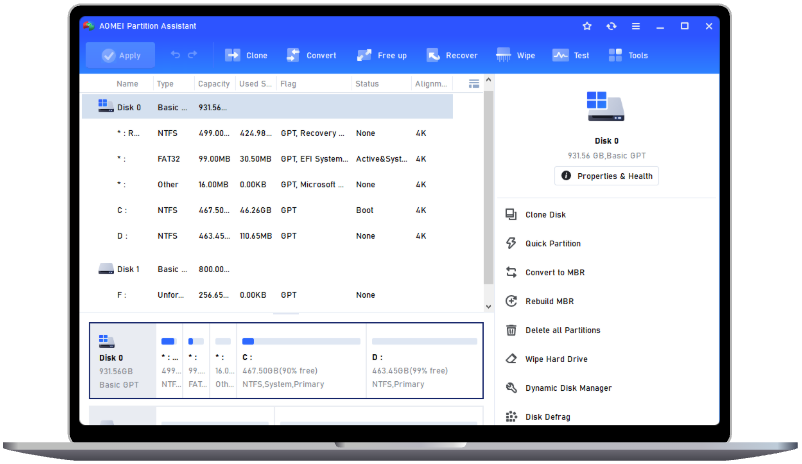GPT Partition Manager: Resize, Convert GPT and More
Learn to use a versatile GPT partition manager to flexibly adjust your disk with easy operations and data safety.
Tips of GPT
Wikipedia defines it as a partition layout standard for a hard disk. GPT, an acronym for GUID Partition Table. GPT features several improvements over the old Master Boot Record (MBR) method of partitioning used with PC BIOS.
The following advantages result from GPT:
▪ GPT uses 64-bit values for addressing purposes, which can address up to 9.4 ZB. It removes the limitation of MBR (only 2 TB).
▪ Support for multiple partitions, 128 partitions in most configurations. The number of primary partitions is limited to 4 for MBR partitions.
▪ GPT has two tables: a primary one, and a secondary one, for backup purposes, so your data security is guaranteed.
▪ Each partition can also be given a descriptive name consisting of 36 characters.
However, nothing is perfect, GPT also has some disadvantages. The disadvantages or problems of the GPT partition table are predominantly related to the issue of compatibility. Older operating systems, such as Windows XP 32-bit, may not be able to work with GPT. Your computer should support UEFI if you want to use a GPT partition as a system disk. The table about GPT supported Windows OS:
|
Operating System |
Data Access |
System Boot |
|
Windows XP 32-bit |
Not Support GPT |
Not Support GPT |
|
Windows XP 64-bit |
Support GPT |
Not Support GPT |
|
Windows Vista 32-bit |
Support GPT |
Not Support GPT |
|
Windows Vista 64-bit |
Support GPT |
Support GPT(Need UEFI) |
|
Windows 7 32-bit |
Support GPT |
Not Support GPT |
|
Windows 7 64-bit |
Support GPT |
Support GPT(Need UEFI) |
|
Windows 8 32-bit |
Support GPT |
Not Support GPT |
|
Windows 8 64-bit |
Support GPT |
Support GPT(Need UEFI) |
|
Windows 10 32-bit |
Support GPT |
Not Support GPT |
|
Windows 10 64-bit |
Support GPT |
Support GPT(Need UEFI) |
|
Windows 11 |
Support GPT |
Support GPT(Need UEFI) |
Especially Windows 11, if Windows 10 users want to use Windows 11 via upgrade, they could only set a GPT disk as the system disk.
GPT partition manager -- AOMEI Partition Assistant
After you have known about the GPT partition, now you might need a GPT partition manager to help you manage and optimize the GPT hard drive. Microsoft has built Windows tools for users, Disk Management and Command Prompt, but if you've tried them or you've searched how to use them to convert your MBR disk to GPT style, you'll find that these tools ask users to delete or clean all data on the disk, it's quite annoying.
But, AOMEI Partition Assistant Professional can easily exchange partition types between MBR and GPT and won't cause data loss even the target disk is a system disk. It also allows you to create/delete/format partitions, convert FAT to NTFS, even migrate OS between MBR disk and GPT disk without reinstalling on your hard drive. With only a few clicks you can resize or move GPT partitions, or hide existing GPT partitions - all without corrupting your data.
Now, we'll show you how to use this powerful tool to convert disk from MBR to GPT as an example:
Step 1. Install and launch the software, right-click the MBR disk you want to change, and then choose "Convert to GPT" or click the disk and choose "Convert to GPT" from the right menu.
Step 2. In the pop-up windows, click "OK" to continue.
Step 3. Click "Apply" to operate and then your disk will be changed into GPT disk style.
Conclusion
As seen from the above table, this reliable tool supports Windows 11/10/8/8.1/7/XP/Vista OS. Besides the features we've mentioned before, you can also use this software to transfer installed programs, clone the whole disk or a single partition, do an SSD secure erase, ...
What's more, for Windows Server, AOMEI Partition Assistant Server supports Windows Server 2025/2022/2019/2016/2012(R2)/2008(R2)/2003(R2) and SBS 2011/2008/2003, also 32-bit and 64-bit. In short, AOMEI Partition Assistant is an excellent partition software, it won’t let you down for its practical features.
